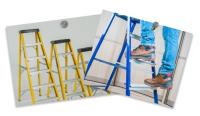 Add My Company
Add My Company
Sign In
What is a Swingback Ladder?
07-12-2022

What is a Swingback Ladder?
One of the most popular pieces of equipment for DIY projects or professional work is a folding step ladder. It's indispensable for tasks requiring moderate height, both inside buildings and out of doors. Although a platform ladder is commonly the first design that comes to mind, many people prefer to choose the swingback ladder. As a multi-purpose ladder, it's convenient and versatile with several advantages.
SWINGBACK LADDER VERSUS PLATFORM LADDER
The swingback ladder has a simple, but sturdy, 'A' frame design. The front section is fitted with a series of flat steps known as treads. The width of the ladder usually narrows considerably as it nears the top. It terminates in a small flat ledge that can be used to hold tools. The ladder folds flat for storage and when opening it, you swing the back section outwards and into position.
The platform ladder is also an 'A' frame style with flat treads on the front half. However, near the upper end, there is a wide, folding platform that provides a large space for positioning tools or pots of paint. The stiles or sides of the ladder usually extend above the platform. The ladder folds flat for storage.
WHY IS THE SWINGBACK LADDER DIFFERENT TO OTHER LADDERS?
One of the main reasons why the swingback ladder is popular is its design. Health and Safety guidelines recommend you should never risk standing on either the top three rungs of any ladder or the large surface at the top of a platform design. The tapered stiles of the swingback ladder make it difficult to step on the treads nearest the top. By comparison, the platform ladder with its generously sized terminal tread, offers the temptation to risk your safety by standing on it. Doing so leaves very little support to help maintain your balance.
HOW SAFE IS A SWINGBACK LADDER?
The wide-angled base of the swingback ladder provides effective stability when placed on a smooth, level surface. The relatively narrow treads towards the top are convenient and sturdy for you to grip. The Health and Safety Executive advises using the hand holds as a guideline on how high to climb. You should always be able to hold onto treads that are within comfortable, easy reach. Always choose a swingback step ladder that has a greater height than the level you want to work at. A twelve tread swingback ladder usually reaches a height of around 3.5 metres.
HOW TO SAFELY USE A SWINGBACK LADDER
Whenever you use a swingback ladder, you should routinely make a few checks regarding its safety. Overall sturdiness is a priority as any loose sections can cause the step ladder to unexpectedly collapse. Check the stiles are straight. If they are bent or misshapen they could affect the balance of the ladder, resulting in it toppling over. The stability of the swingback ladder can be seriously compromised if one or more of the protective feet at the end of the stiles are damaged or missing.
The locking bars at the sides of the stiles keep the ladder's structure rigidly in place. If the locking bars are broken, loose or bent, the ladder could be hazardous. The individual treads can easily be splashed by substances such as grease or wet paint. These can cause you to slip, so don't use the step ladder until the contaminants have been safely removed.
SAFELY POSITIONING THE SWINGBACK LADDER
The swingback ladder should be placed on level ground. The frame should feel stable without rocking to and fro. Clear debris from around the ladder to provide you with a clear space when stepping off the bottom tread. Ensure that any nearby materials such as lengths of timber or crates are stable. If they should suddenly fall against your ladder they could knock it off balance causing you to fall. Never work directly behind a closed door as anyone entering the room could accidentally push your ladder over. Check the height above the ladder can accommodate you when standing nearer the top. Beware of colliding with low ceilings, overhead pipes and electric cables.
WHAT MATERIALS ARE BEST FOR SWINGBACK LADDERS?
The swingback ladder is a versatile step ladder that is available in several materials. The original folding step ladder invented in 1867 by John H. Balsley of Ohio was made of wood. It's still a popular choice today for swingback ladders. However, timber swingback ladders are often uncomfortable to carry due to their excessive weight. For instance, a ten-tread version can weigh an average of 20 kg compared to 11 kg in aluminium and 16 kg for a fibreglass step ladder. Timber frames are also prone to deterioration and warping, particularly when stored or used in damp conditions.
Aluminium swingback ladders are usually the least expensive. They often provide a wide range of heights with up to twelve treads. The metal is resistant to corrosion and extremely lightweight to manoeuvre. It means large aluminium swingback ladders can often be handled by one person. Its strength to weight ratio is even greater than steel. Aluminium swingback step ladders are ideal for completing a succession of tasks in different locations.
Fibreglass is strong and durable. The material is manufactured from a plastic resin reinforced with fibres of glass. The step ladders are often available in vivid colours making them ideal for working in poor light conditions.
HOW TO FIND THE BEST SWINGBACK LADDER FOR YOUR NEEDS
Swingback ladders need to be lightweight if you have to frequently move them to different locations. Always choose a swingback ladder that provides plenty of height for your tasks. When working outdoors, choose a material that can easily withstand damp weather. Your swingback ladder conveniently folds flat for storage. It should provide excellent service for many years.
For more information on What is a Swingback Ladder? talk to Ramsay Ladders
Enquire Now
List your company on FindTheNeedle.

